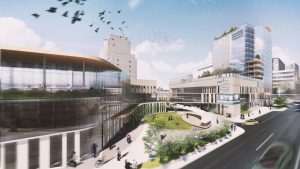Lean construction principles have been crucial to keeping an addictions recovery centre project in Winnipeg running smoothly and to schedule.
“We are able to reduce the number of issues that pop up onsite and we get a clearer picture of the impacts,” by employing lean practices, says Lisa Reichart, project manager with Bockstael Construction, the construction manager for the Bruce Oake Recovery Centre.
She says BockStael is employing the “Last Planner System,” a lean principle that provides “a platform for our trade partners to communicate and work collaboratively.”
The system offers a visual of the plan for construction crews. That can simplify the complexities of sequencing some construction activities, Reichart says.
“Through the weekly work plans, we have a better visual of our real-time progress and are able to make adjustments to sequencing or manpower before large delays are seen,” she explains.
“Instead of time savings, the end result is…optimization and continuous flow, making for a better work environment for all stakeholders.”
Bockstael has used lean on all its projects for about seven years. It has led to “greater schedule certainty as well as workflow and schedule optimization,” Reichart points out.
The recovery centre’s proximity to Sturgeon Creek has resulted in material and equipment laydown restrictions.
While just-in-time deliveries have been critical, an “accommodating neighbour,” the Assiniboine Curling Club, allowed the project’s construction manager to store the site’s excavated soil on its property until it was ready for reuse as backfill for the new building’s foundation, says Reichart.
Another hurdle the builder overcame concerned unforeseen soil conditions that hampered the installation of the cast-in-place piles for the basement.
“We ended up doing some complex resequencing for our foundation concrete in order to claw back that lost time,” she adds.
Reichart says Bockstael conducted a “threat and vulnerability analysis” concerning COVID-19 to manage the supply chain. Reviews of various pandemic issues are carried out daily with all of the trades. Virtual meetings are encouraged, she says, adding every one entering the project is screened.
The project manager adds the building layout allows the trades to be spaced apart.
“The pandemic definitely provided some challenges for the project,” she states. “However, we have no sequencing issues that are specifically pandemic driven at this time.”
The two-storey recovery centre will have 50 beds to help take pressure off existing residential treatment services in the province.
The structural steel building will be clad in a combination of an aluminum curtainwall, EIFS, brick and cement panel siding. A double-sided natural gas fireplace will serve both interior and outdoor spaces. The project’s designer is MMP Architects Inc.
Bockstael started the project a year ago with the demolition of an arena on the site. Substantial completion of the new building is slated for next spring.
The centre is dedicated to the memory of Bruce Oake, who passed away from an accidental drug overdose in 2011. His parents Scott and Anne Oake and brother Darcy Oake have been an “immoveable force behind realizing the vision” for the facility, Reichart says.











Recent Comments
comments for this post are closed